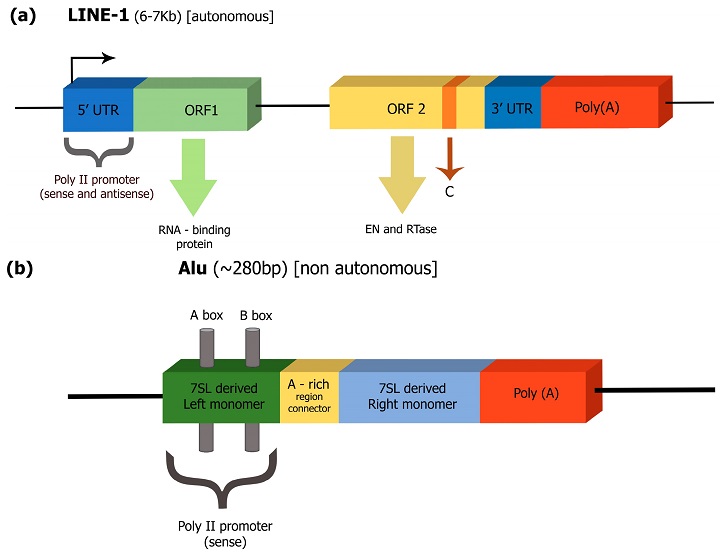Nikhil Prasad Fact checked by:Thailand Medical News Team Nov 11, 2024 5 months, 2 days, 4 hours, 49 minutes ago
Medical News: A groundbreaking study by researchers from the University of Ioannina-Greece and the National and Kapodistrian University of Athens-Greece is shedding light on the connection between specific DNA elements, known as retrotransposons, and diabetes. Retrotransposons are DNA sequences that can copy and move themselves to new locations within the genome, potentially altering gene function. This
Medical News report reviews findings on the roles of these DNA elements in diabetes, exploring how changes in their behavior might affect disease development.
 Uncovering the Link Between Retrotransposons and Diabetes
Examples of the structure of retrotransposons. (a) Structure of LINE-1: Autonomous elements (such as LINE-1) encode the protein activities essential for retrotransposition, such as a reverse transcriptase and an endonuclease. The arrow at the 5′ end of retrotransposons indicates the transcription start site from their internal promoter. (b) Structure of Alu: Nonautonomous elements (such as Alu) do not encode proteins and their retrotransposition relies on proteins encoded by autonomous elements [15]. ORF: open reading frame; UTR: untranslated-region sequences; EN: endonuclease; Pol II: RNA polymerase II promoter; Pol III: RNA polymerase III promoter (bars labeled A and B); C: denotes cysteine-rich domain (encoded by ORF2); A-rich: adenosine-rich (AR) linker.
Retrotransposons and Their Role in the Human Genome
Uncovering the Link Between Retrotransposons and Diabetes
Examples of the structure of retrotransposons. (a) Structure of LINE-1: Autonomous elements (such as LINE-1) encode the protein activities essential for retrotransposition, such as a reverse transcriptase and an endonuclease. The arrow at the 5′ end of retrotransposons indicates the transcription start site from their internal promoter. (b) Structure of Alu: Nonautonomous elements (such as Alu) do not encode proteins and their retrotransposition relies on proteins encoded by autonomous elements [15]. ORF: open reading frame; UTR: untranslated-region sequences; EN: endonuclease; Pol II: RNA polymerase II promoter; Pol III: RNA polymerase III promoter (bars labeled A and B); C: denotes cysteine-rich domain (encoded by ORF2); A-rich: adenosine-rich (AR) linker.
Retrotransposons and Their Role in the Human Genome
Retrotransposons, including LINE-1 and Alu elements, make up nearly 40% of our DNA. Although these sequences are often dormant, under certain conditions they can “jump” to new genome locations. While this mobility has been useful for evolution, it can also disrupt gene function. Retrotransposons are typically controlled by DNA methylation, an epigenetic modification that silences these sequences. When this control weakens, retrotransposons become more active, potentially destabilizing the genome.
The Link Between Retrotransposons and Diabetes
The study examined how methylation of LINE-1 and Alu elements could influence diabetes risk. LINE-1 and Alu methylation levels were analyzed in patients with Type 1 and Type 2 diabetes, revealing a pattern of hypomethylation (decreased methylation) in these elements among individuals with diabetes. The study team explains that hypomethylation is associated with genomic instability, which is increasingly recognized as a contributor to aging and metabolic diseases, including diabetes.
Key Findings on LINE-1 Methylation and Diabetes
The study highlighted several key findings regarding LINE-1 methylation:
-Metabolic Risks: Research has shown that low LINE-1 methylation levels are linked to metabolic risk factors like high blood sugar and insulin resistance. In patients with Type 2 diabetes, low baseline LINE-1 methylation increased the likelihood of worsened glucose metabolism over time.
-Dise
ase Progression: Patients with lower LINE-1 methylation at the beginning of the study experienced more severe disease progression, with worsening insulin resistance and higher levels of blood sugar. These observations suggest that LINE-1 hypomethylation might serve as an early warning sign for Type 2 diabetes.
Alu Methylation: A Unique Indicator
Unlike LINE-1, Alu elements do not produce their own proteins to support their movement and must rely on other retrotransposons like LINE-1. Researchers discovered that Alu hypomethylation is linked with poor blood sugar control and high blood pressure. Some studies even suggest that changes in Alu methylation are more pronounced in diabetes than those of LINE-1.
Clinical Implications: Using LINE-1 and Alu as Biomarkers
The study indicates that methylation of LINE-1 and Alu elements could serve as valuable biomarkers for predicting diabetes risk and disease progression. By measuring methylation levels, clinicians might be able to identify patients at risk of developing diabetes-related complications and tailor their treatment accordingly. In addition, these biomarkers may offer a non-invasive method for tracking disease progression and treatment effectiveness.
Future Research Directions
More studies are needed to confirm the role of retrotransposon methylation in diabetes and to understand how these changes influence disease mechanisms. Researchers suggest that analyzing LINE-1 and Alu methylation might provide more accurate insights into the molecular underpinnings of diabetes. With advancements in genetic sequencing technologies, future studies could explore how environmental factors, such as diet or exposure to pollutants, influence retrotransposon methylation and contribute to diabetes risk.
Conclusion
The research conducted by institutions in Greece offers promising insights into the role of retrotransposon methylation in diabetes. By understanding how LINE-1 and Alu elements contribute to the disease, scientists hope to develop new diagnostic tools and treatments. For now, these findings underscore the importance of epigenetic research in tackling complex diseases.
The study findings were published in the peer-reviewed journal: Epigenomes.
https://www.mdpi.com/2075-4655/8/3/35
For the latest on Retrotransposons, keep on logging to Thailand
Medical News.
Read Also:
https://www.thailandmedical.news/news/must-read-study-proposes-role-of-sars-cov-2-spike-protein,-stem-cells-and-retrotransposons-in-long-covid-syndrome
https://www.thailandmedical.news/news/breaking-long-covid-is-a-misnomer-the-conditions-are-being-caused-by-viral-persistence-and-viral-peptides-similar-to-retrotransposons-and-introns
